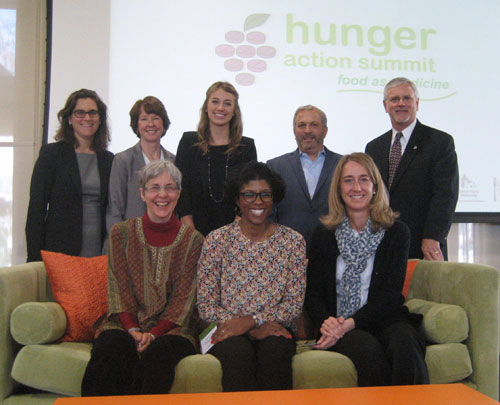
Who’s hungry? You can’t tell by looking. You have to ask: Within the past 12 months, have you ever worried about whether food would run out? Within the past 12 months, have you ever had food run out and not had the money to buy it?
Thirty percent of residents in Santa Clara and San Mateo Counties would answer “yes” if asked these critical questions, which are used to help identify the hungry—the food insecure—in Silicon Valley.
At the annual Hunger Action Summit held Jan. 30 at Santa Clara University’s Locatelli Center, more than 200 local leaders considered the premise of “Food as Medicine: The Intersection of Hunger and Health.” What are the health consequences of going hungry, what already is being done and what more could be done to reduce hunger and its consequences were the driving questions of the day.
As lead presenter for the summit, organized by Second Harvest Food Bank of Santa Clara and San Mateo Counties and Santa Clara University, S. Andrew Starbird, Ph.D., Dean of the Leavey School of Business, presented the university’s 2013 Hunger Index for the two counties.
The slightly good news is that the number of low-income households (those with annual incomes under $50,000) declined slightly in 2013, thus reducing the meal gap. The meal gap is the number of meals families need but can’t afford to buy and that are not provided through food-assistance programs. In 2013, even though local programs provided 221 million meals, there was a gap (shortfall) of 176 million meals.
Every month, Second Harvest serves enough people to “fill Levi’s Stadium with people four times,” says CEO Kathy Jackson, who spoke about the food bank’s “Prescription for Health.” Jackson notes a shift from meeting emergency hunger needs to meeting chronic needs, with families trading off expenses, such as food vs. rent, and watering down milk to make it go farther.
In line with the “food as medicine movement” is a shift in focus from viewing food banks and pantries not just as food providers but health care providers.
“When we provide food, we provide a foundation for health,” says Jackson. “We see a lot of diet-related disease in our clients.”
Pediatricians Lisa Chamberlain (Lucile Packard’s Children’s Hospital) and Rhea Boyd (Palo Alto Medical Clinic) discussed the importance of adequate nutrition to early childhood development, particularly in the first three years. Dr. Hilary Seligman (UCSF) spoke about “The Intersection of Food Insecurity and Chronic Disease,” focusing on diabetes.
Second Harvest’s prescription for health includes providing plenty of fresh produce—enough in 2014 to fill 1,000 tractor trailers. The food bank also provides nutrition education so families will shop smarter and know how to prepare nutritious, tasty meals.
It is hoped that food providers and medical clinics can better cooperate to identify the hungry and sign them up for dual enrollment in CalFresh and Medi-Cal. More than 50 percent of those who qualify for CalFresh government food assistance don’t know they qualify. Second Harvest is opening “food pharmacies” at hospitals.
Funded by Second Harvest and El Camino Hospital Foundation, beginning in February, Sunnyvale Community Services will pilot “The Challenge Diabetes Program.” Clients can be tested for diabetes and provided with food boxes tailored to meet their medical needs.
“It’s an exciting and challenging project,” says Executive Director Marie Bernard.
Robert Greenwald, J.D., director of Harvard Law School’s Center for Health Law and Policy Innovation, discussed the potential of public and private health insurance as an added source of revenue for providers of medically-tailored food such as the diabetes boxes.
“It’s unacceptable that we have hungry kids in Santa Clara County, one of the richest counties in the nation,” says Dana Bunnett, Director of Kids in Common in San Jose. “It’s great to learn about solutions and that the solutions are within reach.”
To view a video stream of all the presentations at the summit, visit www.shfb.org.






